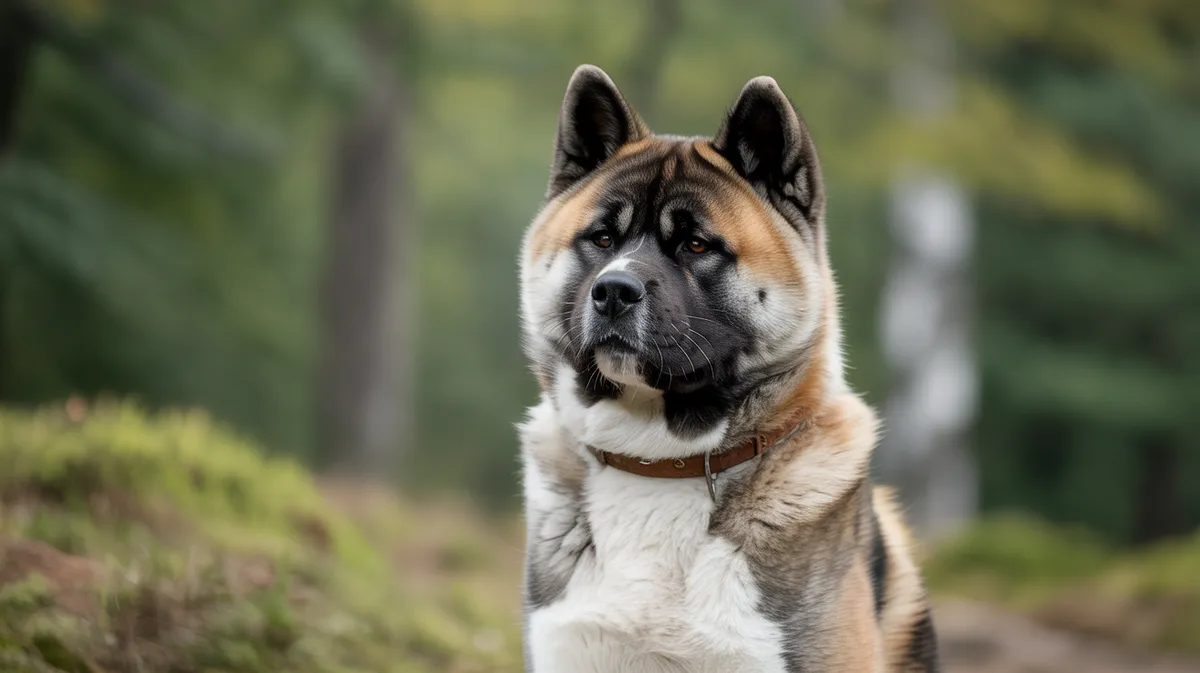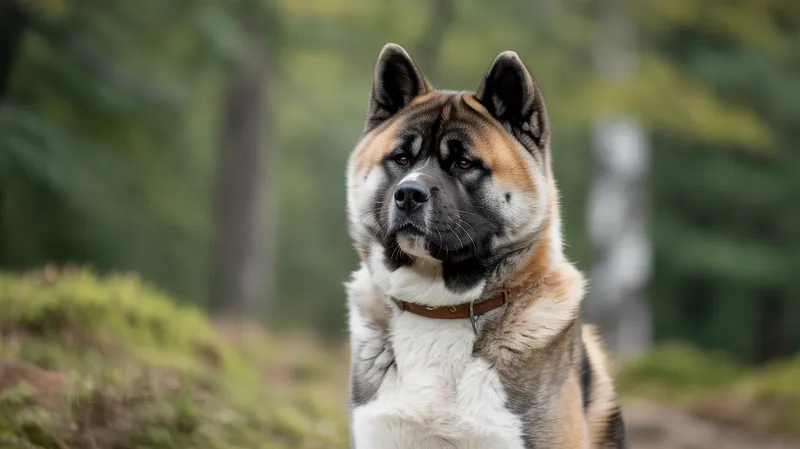
Akita Dog
Canis lupus familiaris

Meet the Akita Dog
The Akita is a large and powerful dog breed originally from the mountainous regions of northern Japan. Renowned for their strength, courage, and unwavering loyalty, Akitas were historically used for guarding nobility and hunting large game such as bears and boars. They have a thick double coat, erect ears, and a curled tail, giving them a striking wolf-like appearance. Akitas are known for being reserved and dignified with strangers but affectionate and protective with their families. Their independent and intelligent nature requires consistent training and socialization.
Classification
Mammal
Habitat
Domestic, originally mountainous and forested regions
Diet
Omnivore
Lifespan
10-15 years
Conservation
Least Concern
Weight
32-59 kg (70-130 lbs)
📖Fascinating Facts
Ancient Breed
The Akita is one of the oldest and most unique dog breeds from Japan, with origins dating back to at least the 17th century.
Loyal Legend
Hachiko, an Akita, became a national symbol of loyalty in Japan after waiting for his owner every day for nearly a decade after his owner's death.
Snow Adapted
Akitas have thick double coats and webbed toes, adaptations that help them thrive in snowy, cold climates.
📋Detailed Description
The Akita is a robust, large-boned dog breed, typically standing 64–71 cm (25–28 in) at the shoulder for males and 58–66 cm (23–26 in) for females, with weights ranging from 27–59 kg (60–130 lb) in males and 25–45 kg (55–100 lb) in females. Their dense double coat, composed of a harsh, straight outer layer and a soft, insulating undercoat, provides excellent protection against cold climates, reflecting their origins in the snowy mountains of northern Japan. The breed’s broad head, small triangular eyes, erect ears, and curled tail are characteristic of spitz-type dogs, contributing to their alert and dignified appearance. Akitas possess a powerful, muscular build, enabling them to perform demanding tasks such as hunting large game and guarding property. Behaviorally, they are known for their independence, intelligence, and strong territorial instincts, often displaying aloofness toward strangers but deep loyalty to their family group. Socially, Akitas tend to form close bonds with a limited number of people and can be reserved or even intolerant of unfamiliar dogs, especially those of the same sex. Reproductively, Akitas have moderate litter sizes, averaging 7–8 puppies, and exhibit attentive maternal care. Their vocalizations are generally limited, but they communicate through a range of subtle body signals and low-pitched sounds. Unique adaptations include their thick coat, webbed toes for traction in snow, and a high degree of problem-solving intelligence, all of which have contributed to their historical roles as hunters and guardians.
💡 Did you know?
In Japan, small Akita statues are often given to people as a token of health and good fortune.
🔬Research & Sources
Wikipedia Summary
The Akita is a Japanese dog breed of large size. Originating from the mountains of northern Japan, the Akita has a short double coat similar to that of many other northern spitz breeds. Historically, they were used by matagi for guarding and the hunting of bears.
Last Modified: 5/25/2025
🎭Behavior & Social Structure
Akitas are typically calm and composed, with a strong sense of routine and territory. They are not prone to excessive barking, instead relying on body language and low growls to communicate. Historically, Akitas were used by matagi (traditional hunters) for tracking and holding large game such as bears, boars, and deer, demonstrating remarkable courage and tenacity. Their hunting behavior is marked by stealth, patience, and explosive bursts of energy. In domestic settings, Akitas may display guarding behaviors, such as patrolling their home and being wary of strangers. Social interactions with humans are characterized by loyalty and protectiveness, but with other dogs, especially those of the same sex, Akitas can be dominant or aggressive without early socialization. Daily routines often include periods of alert watchfulness interspersed with rest, and they benefit from regular exercise and mental stimulation to prevent boredom and destructive behaviors.
👶Reproduction & Life Cycle
Akitas reach sexual maturity between 8 and 12 months, though breeding is typically recommended after 18 months to ensure physical and behavioral maturity. The breed is monoestrous, with females coming into heat once or twice a year. Mating is usually preceded by a courtship period involving scent marking and play behaviors. The gestation period averages 63 days, after which litters of 3–12 puppies (commonly 7–8) are born. Akita mothers are attentive, providing warmth, grooming, and protection to their offspring. Puppies are altricial, born blind and deaf, and begin to open their eyes at around 10–14 days. Weaning occurs at 4–6 weeks, and socialization during this period is critical for behavioral development. Breeding is often managed by reputable breeders to maintain genetic diversity and minimize inherited health issues.
🛡️Adaptations & Survival
Physically, the Akita’s thick double coat insulates against harsh winter conditions, while their webbed toes and powerful limbs aid movement through snow and rough terrain. Their curled tail helps conserve body heat and signals emotional states. The breed’s acute senses of smell and hearing are well-developed for tracking prey and detecting intruders. Behaviorally, Akitas exhibit high intelligence, independence, and problem-solving abilities, traits selected for in their historical roles as hunters and guardians. Their reserved nature and low vocalization rates reduce detection by prey and potential threats. Akitas also show a strong memory and capacity for learning complex tasks, making them effective working dogs.
🎨Cultural Significance
The Akita holds deep cultural significance in Japan, symbolizing loyalty, bravery, and good health. The breed is the official animal of Akita Prefecture and is celebrated in folklore and popular culture. The story of Hachikō, an Akita who waited for his deceased owner at a Tokyo train station for nearly a decade, epitomizes the breed’s renowned loyalty and has become a national symbol of devotion. Akita figurines are often given as gifts to convey wishes for health and happiness. Historically, Akitas were also status symbols among the samurai and nobility, and their images appear in traditional art and literature.
🔬Recent Research & Discoveries
Recent genetic studies have confirmed the Akita’s ancient lineage, showing close relationships with other East Asian spitz breeds and evidence of limited admixture with Western breeds. Ongoing research focuses on the breed’s predisposition to autoimmune diseases, with studies identifying specific genetic markers associated with conditions like VKH-like syndrome and hypothyroidism. Behavioral research highlights the importance of early socialization and training in preventing aggression and anxiety. Conservation genetics efforts in Japan aim to preserve the native Akita Inu’s unique genetic heritage, distinguishing it from the American Akita, which has diverged due to crossbreeding in the 20th century.
🎥Wildlife Videos

Wildlife - Just Wild Dogs | Free Documentary Nature
Wildlife - Episode 7: Just Wild Dogs | Wildlife Documentary Watch 'Wildlife - Episode 8' here: https://youtu.be/kglJpB4ei8o Run ...
Free Documentary - Nature

THE AKITA - JAPANESE BEAR HUNTING DOG
The Akita is one of the world's most revered canines, originating in Akita, Japan from bear hunting dogs. Did you know that there ...
Animal Watch
![Wild Dogs | National Geographic Wild Documentary [Full HD 1080p]](https://i.ytimg.com/vi/hLzJQMSZsBc/maxresdefault.jpg?sqp=-oaymwEjCOADEI4CSFryq4qpAxUIARUAAAAAGAElAADIQj0AgKJDeAE=&rs=AOn4CLD1P29nAgV5B0HftxePWF9HqSCkRw)
Wild Dogs | National Geographic Wild Documentary [Full HD 1080p]
Wild Dogs | National Geographic Wild Documentary [Full HD 1080p] #wildplanet #wilddogs #documentary ----------------------- The ...
Wild Planet

THE AFRICAN WILD DOG: Nature’s Most Ruthless Pack Hunter Unleashed! | Animal Documentary
THE AFRICAN WILD DOG: Nature's Most Ruthless Pack Hunter Unleashed! | Animal Documentary THE AFRICAN WILD DOG: ...
WILD WORLD - Animal Documentary

Akitas: The Most Loyal Dogs on Earth 🐾 | Critter Chronicles Ep. 5
Welcome back to Critter Chronicles — the channel where we explore fun and fascinating animal facts from A to Z! In Episode 5, ...
Critter Chronicles

THE JAPANESE AKITA INU - Difficult & Dangerous or Loyal Guardian? - 秋田犬
The Japanese Akita Inu is the original pure Japanese Akita, revered across Japan for his beauty, loyalty and dignity. He has even ...
Animal Watch
🌍Habitat Information
The Akita Dog typically inhabits Domestic, originally mountainous and forested regions environments. Akita Dogs have adapted to their environments with specialized features and behaviors.
Primary Habitat:
Domestic, originally mountainous and forested regions
More detailed habitat information will be available soon.
🛡️Conservation Status
The Akita Dog is currently classified as Least Concern. Conservation efforts are crucial for preserving this species for future generations.
Common Threats:
- 🏠Habitat loss and fragmentation
- 🌡️Climate change impacts
- 🎯Hunting and poaching
- 🏭Human-wildlife conflict
⚠️Threats & Conservation Challenges
While the Akita is not considered at risk globally, certain challenges affect the breed. In Japan, the native Akita Inu population faces genetic dilution from crossbreeding and a limited gene pool, leading to concerns about hereditary diseases such as hip dysplasia, autoimmune disorders, and progressive retinal atrophy. In some countries, Akitas are subject to breed-specific legislation due to their size and protective instincts, which can impact their popularity and welfare. Responsible breeding, early socialization, and public education are essential to address behavioral issues and maintain breed health. Population trends remain stable, but ongoing monitoring is recommended to prevent loss of genetic diversity.
🔬Scientific Classification
Scientific Name
Canis lupus familiaris
Classification Hierarchy
🔍 About Taxonomic Classification
Taxonomic classification is a hierarchical system used by scientists to classify and organize living organisms based on shared characteristics and evolutionary relationships.
The system moves from broad categories (Kingdom) to increasingly specific ones, with each animal's scientific name typically consisting of its Genus and species.
📝Community Notes
Share your observations and insights about the Akita Dog with our community of wildlife enthusiasts.
Join Our Community
Sign in to share your observations and connect with fellow wildlife enthusiasts.
Sign In to ContributeNo community notes yet
Be the first to share your observations about the Akita Dog!
Explore Akita Dog
Select a tab above to learn more about this amazing animal.
📸Photo Gallery
No photos available for this animal yet.
🌟Discover More Wildlife
Continue your journey of discovery with more fascinating animals from our database
